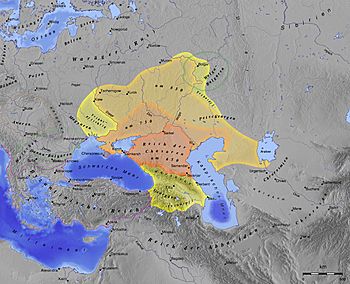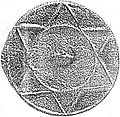Khazars facts for kids
Quick facts for kids
Khazar Khaganate
Xəzər Xaqanlığı |
|||||||||||||
|---|---|---|---|---|---|---|---|---|---|---|---|---|---|
| c. 650–969 | |||||||||||||

Khazar Khaganate, 650–850
|
|||||||||||||
| Status | Khazar Khaganate | ||||||||||||
| Capital |
|
||||||||||||
| Common languages | Khazar | ||||||||||||
| Religion | |||||||||||||
| Qaghan | |||||||||||||
|
• 618–628
|
Tong Yabghu | ||||||||||||
|
• 9th century
|
Bulan | ||||||||||||
|
• 9th century
|
Obadiah | ||||||||||||
| History | |||||||||||||
|
• Established
|
c. 650 | ||||||||||||
|
• Sviatoslav's sacking and razing of Atil
|
969 | ||||||||||||
| Area | |||||||||||||
| 850 est. | 3,000,000 km2 (1,200,000 sq mi) | ||||||||||||
| 900 est. | 1,000,000 km2 (390,000 sq mi) | ||||||||||||
| Population | |||||||||||||
|
• 7th century
|
1,400,000 | ||||||||||||
| Currency | Yarmaq | ||||||||||||
|
|||||||||||||
The Khazars were a group of Turkic people who were semi-nomadic. This means they moved around a lot but also had some settled areas. They created an empire called Khazaria in what is now Russia. This empire lasted from about the 6th to the 10th century CE.
The Khazars came from the Western Turkic Khaganate. This was a large empire on the Eurasian Steppe, a huge grassland. After the Western Turkic Khaganate was conquered by Tang China, the Khazars formed their own state.
Khazaria became a very important place for international trade. It was a key stop on the famous Silk Road. This ancient trade route connected China, the Middle East, and the Kievan Rus (an early East Slavic state). For about 300 years (from around 650 to 965 CE), the Khazars controlled a large area. This stretched from the Volga-Don steppes to Crimea and the Caucasus mountains.
Khazaria was located between powerful empires: the Byzantine Empire, the nomadic groups of the steppe, and the Umayyad Caliphate (a large Islamic empire). Khazaria helped the Byzantine Empire protect itself from the Sasanian Persian empire. This alliance ended around the year 900. Between 965 and 969, the Kievan Rus' took over Khazaria.
The main religion of the Khazars might have been Tengrism. This was a common belief among groups like the Huns and other Turkic peoples. Other major religions, known as Abrahamic religions, were also popular. These include Judaism, Christianity, and Islam. Some historians believe that the Khazar ruling class converted to Judaism in the 8th century.
Some people think that modern groups like the Cossacks, Muslim Kumyks, Kazakhs, and even some Jews, such as the Ashkenazi Jews, might be descended from the Khazars. However, not everyone agrees with this idea.
Contents
What Does "Khazar" Mean?
The name Khazar, or Xazar, might come from an older word, *Qasar. In Turkic languages, the word qaz- means "to ramble" or "to roam." This is similar to the word kez- in many Turkic languages.
Other ideas suggest the name comes from qas-, meaning "to rule harshly" or "to terrorize." This is similar to the Uyghur name Qasar.
Some believe it was the name of a person or a tribe. For example, the Chinese name Kesa for "Khazars" might refer to a tribe called Gésà. However, others say Kesa was the name of a chief, not a tribe.
The Khazar language is no longer spoken today. But even now, modern Turkic languages often call the Caspian Sea the "Khazar Sea."
What Language Did They Speak?
We don't have many records of the Khazar language itself. Khazaria was a place where many different languages were spoken, and many different ethnic groups lived together.
The ruling class likely spoke a dialect of Shaz Turkic. The common people might have spoken Lir Turkic, which includes languages like Oğuric, Bulğaric, and Chuvash. A Persian historian named al-Iṣṭakhrī wrote that the Khazar language was "different from any other known language."
After some Khazars became Jewish, they might have started writing in the Hebrew alphabet. Even though they spoke a Turkic language, they may have also learned to speak Hebrew.
The Story of the Khazars
Where Did the Khazars Come From?
The Khazars seem to have originated in Mongolia or northern China. This was after the Xiōngnú (also known as the Huns) were defeated by the Han dynasty of China. The early Khazar tribes probably included people from Iranian, proto-Mongolic, Uralic, and Palaeo-Siberian backgrounds.
Turkic tribes might have started conquering the western Eurasian Steppe as early as 463 CE.
In 552 CE, these tribes conquered the Rouran Khaganate. They then moved westward, bringing more people from Sogdia into their group.
The Khazar ruling family may have come from the Āshǐnà clan. This clan was part of the West Türkic tribes. Chinese and Arabic historical records support this idea. A leader named Yǐpíshèkuì, who died around 651 CE, might have been important to their early history. As they moved west, the Khazars reached a group called the Akatziroi. These people were allies of the Byzantine Empire and fought against Attila the Hun's army.
How Did Khazaria Begin?
Khazaria began after 630 CE. It formed from the remains of the Göktürk Qağanate. This large Turkic empire was broken up by Tang China between 630 and 650 CE.
Göktürk armies had already reached the Volga River by 549 CE. The Āshǐnà clan, whose tribal name 'Türk' meant "the strong one," arrived in 552 CE. They overthrew the Rourans and created the Göktürk Qağanate.
The Chinese Tang Dynasty defeated the Turkic Qağanate. They set up their own control over parts of Inner Asia. The large Khaganate then split into many smaller tribes. Some of these tribes moved west to the Sea of Azov area. The Ashina clan and the Khazars went even further west.
By 657 CE, a Chinese general named Sū Dìngfāng had taken control of many Turkic groups and Central Asia. The Chinese established their power over the Turkic tribes to the east. By 659 CE, the Chinese had defeated the remaining tribes. The Khazars did not dare to return east.
Instead, the Khazars defeated the Bulgars, another group living further west.
This is how the Khazar Qaganate was born. It rose from the ruins of a nomadic empire that had been destroyed by the Tang armies. Khazaria became the westernmost new state to emerge from the Göktürks.
The Khazars conquered the lower Volga River region. They also took control of the area between the Danube and the Dniepr rivers. In 670 CE, they also conquered the Onoğur-Bulğar union. They even made the Onogur-Bulgar language the official language of their empire, a lingua franca (a common language used by different groups).
Historians sometimes call this period the Pax Khazarica. This means "Khazar Peace," because the state became a major center for international trade and was quite stable.
A historian named Ibn al-Balḫî wrote around 1100 CE that a Sasanian Shah (ruler) named Ḫusraw 1 once said there were only three kings as powerful as he was: the King of China, the King of Byzantium, and the King of the Khazars. This shows how respected the Khazar ruler was.
Images for kids
-
This jug with golden medallions, from the Treasure of Nagyszentmiklós, shows a warrior and his captive. Experts are not sure if the warrior is a Khazar, a Pannonian Avar, or a Bolgar.
-
Sviatoslav I of Kiev (in the boat) was the ruler who destroyed the Khazar Khaganate.
-
A map of the Pontic steppes around 1015 CE. The areas in blue might still have been under Khazar control.
See Also
 In Spanish: Jázaros para niños
In Spanish: Jázaros para niños









